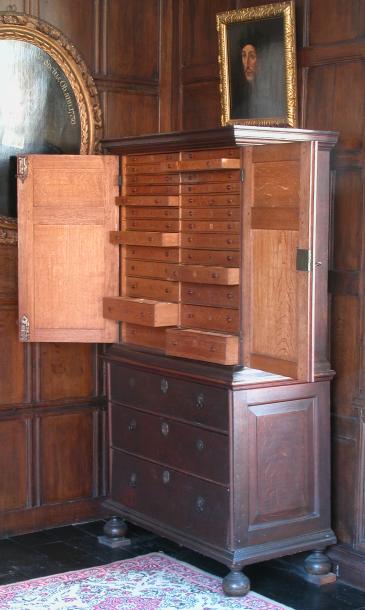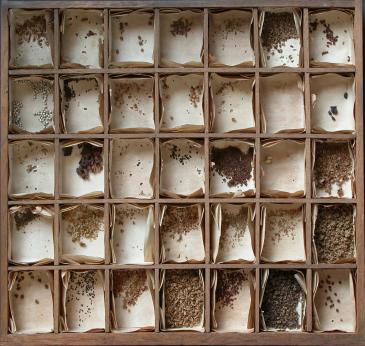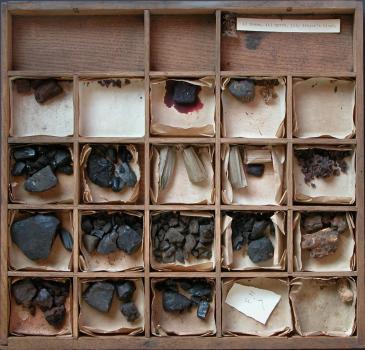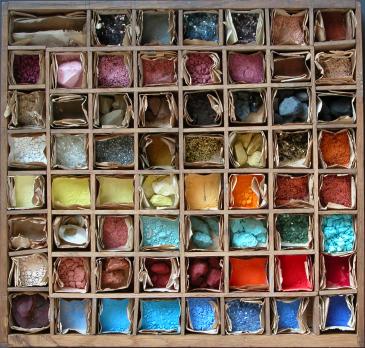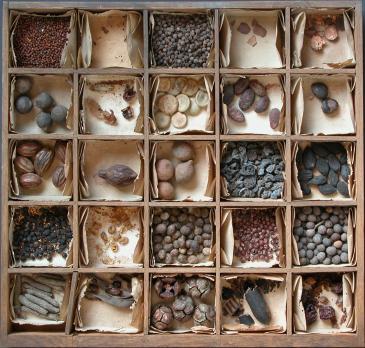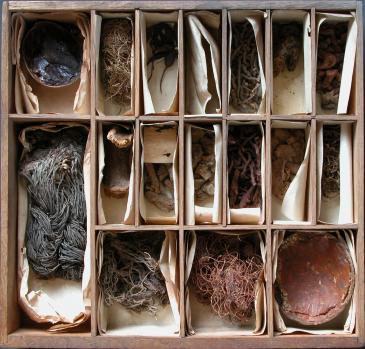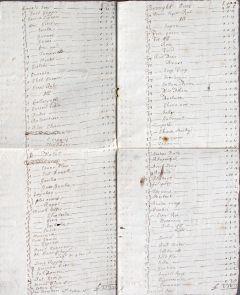Vigani’s Cabinet, in Queens’ College, holds a remarkably well-preserved collection of Materia Medica assembled by John Francis Vigani, first Professor of Chemistry (1703–12) in the University of Cambridge. The cabinet was made in 1704, and the collection of nearly 700 samples of Materia Medica assembled 1704–5, all at the expense of Queens’ College. The collection today survives nearly untouched, and mostly in its original condition.
Vigani’s title of “professor”, awarded 1702/3 February 10 [Grace Book Θ, p. 490], was a purely honorary one, with no specified duties and no stipend. He had been giving chemical teaching and demonstrations in Cambridge for around 20 years previously, some of them at Queens’ College. He is not known to have been a member of any college, or of the university. His income derived from charging his audiences.
In 1704, the cabinet cost £10, and the sub-set of specimens for which we have invoices cost £63 10s. 4½d. — in today’s values possibly over £10,000 [2007 pp. 76–7]. It is not fully understood why Queens’ College made such substantial purchases on behalf of a person who was not formally associated with the college. In that period, university financial transactions were normally overseen by the University Proctors. For the academic year 1703–4, one of the University Proctors was Poley Clopton, who was simultaneously Bursar of Queens’ College. It was Clopton (Fellow 1696–1725, died 1730) who handled the administration of the Vigani purchases. Clopton studied medicine, and was awarded the degree of Doctor of Medicine (or Physick) in 1705.
In 1707, Vigani moved his lectures to Trinity College, in the laboratory newly created by the Master, Richard Bentley:
John Francis Vigani, a native of Verona, having resided in Cambridge and taught chemistry with reputation for about twenty years, received in the year 1702 [old-style] a strong mark of the approbation of the University, by being invested with the title of Professor of Chemistry. To serve the purposes of science, and promote the celebrity of his College, Dr. Bentley resolved to transplant him and his lectures into Trinity. Accordingly he repaired and fitted up an old lumber house as an elegant chemical laboratory; and here Vigani regularly delivered his courses of lectures for some years.
[The Life of Richard Bentley, by James Henry Monk, 2nd ed., 1833, Vol. 1, p. 204]
However, the cabinet, having been paid for by Queens’, stayed behind. Around 1708/09 Vigani ceased teaching at Cambridge. He died February 1712/3 at Newark.
Henry James (President 1675–1717) left £40 by will towards the cost of the Materia Medica in the Lodge [Commemoration of Benefactors, late 18th C., p. 6]. Poley Clopton also left £20 by will to the college [Suffolk Manorial Families, by Joseph James Muskett, 1894, Vol. 1, p. 141].
The best account of the collection and its documentation is given in [2007 Wagner, 852 pages].
The cabinet was constructed of oak, by John Austin, a local joiner. In the cabinet, the 26 upper drawers are all 15½ inches wide by 15 inches deep, of varying heights. The three lower drawers are 32½ inches wide by 17 inches deep, of varying heights. All drawers except the bottom one are subdivided into smaller compartments by wood dividers.
The Materia Medica collection:
| 30: Gum Tragacanth | 29: Ammoniacum | 28: Bdellium | 27: Galbanum | 26: Sandaracha | 25: Gum Guaiaci |
| 24: Gum Elemi | 23: Pix Burgundica | 22: Tacamahaca | 21: Gum Copal | 20: Scammonium | 19: Styrax non calam. |
| 18: Sagapenum | 17: Benzoin | 16: Arabicum | 15: Opopanax | 14: Cambogium | 13: Olibanum |
| 12: Styrax Calam. | 11: Mastiche | 10: Gum Hedeoma | 9: Gum Carannae | 8: Gum Lacca in Massis | 7: Gum Lacca in Granis |
| 6: Euphorbium | 5: Gum Animi | 4: Labdanum Verum Antiquorum | 3: Labdanum | 2: Gum Senica | 1: G. Saviocolla |
 Drawer B is unused.
Drawer B is unused.
| 35: Sem. Levistici | 34: Sem. Cardui Benedicti | 33: Sem. Sumach | 32: Sem. Bardanae | 31: Sem. Colocynthidos | 30: Sem. Faeniculi Com. | 29: Sem. Genistae |
| 28: Sem. Milii Salis | 27: Sem. Basilici | 26: Sem. Angelicae | 25: Sem. Coriandri | 24: Sem. Petroselini vulg. | 23: Sem. Bombycis | 22: Sem. Alexandr. |
| 21: Sem. Urticae | 20: Sem. Cydoniorum | 19: Sem. Portulacae | 18: Sem. P?g???a Rom | 17: Sem. Cochlearia | 16: Sem. Carthami | 15: Sem. Anethi |
| 14: S. P???gi? nigr. | 13: Sem. Lactuca | 12: Sem. Hyoscyami | 11: Sem. Cichorii | 10: Sem. Apii | 9: Sem. Santonicum | 8: Sem. Anisi |
| 7: Sem. Moschi | 6: Semen Psyllii | 5: Semen Ebuli | 4: Sem. Cymini | 3: Sem. Thlaspios | 2: S. Saxifragiae | 1: Sem. Cardamomi |
| 35: Sem. Illicium Anisatum? | 34: | 33: Sem. Colocynthus | 32: ?? | 31: Sem. Cucurbit | 30: Sem. Nasturtii | 29: Sem. Cataputiae |
| 28: Sem. Seselios | 27: Sem. Papaveris alb. | 26: Sem. Foenugraeci | 25: Sem. Staphis agria | 24: Sem. Faeniculi dulcis? | 23: Sem. Plantaginis | 22: Sem. Ammeos |
| 21: Sem. Endiviae | 20: Sem. Amomi | 19: Sem. Dauci Com. | 18: Sem. Pepon | 17: Sem. Cucumeris | 16: Sem. Cucurbitae | 15: Sem. Melonum |
| 14: Sem. Althaea | 13: Sem. Agni Castrum | 12: Sem. Petroselini maced. | 11: Sem. Erucae | 10: Sem. Dauci Cretici | 9: Sem. Paeoniae | 8: Sem. Cardamomi min. |
| 7: Sem. Acetosae | 6: Orange pips | 5: Sem. Lini | 4: Lupini | 3: Sem. Sinapisi | 2: Carum Carvi | 1: Semen Rutae |
| 30: Cinnabaris factitia | 29: Cinnabaris nativi alia Species | 28: Cinnabaris nativi al. Species | 27: Cinnabaris nativa Hungaricus | 26: Cinnabaris nativum é Guinea | 25: Cinnabaris nativa Persica |
| 24: Cerussa | 23: Minium | 22: Sulphur nativum Lancashiense | 21: Sulphur nativum Persicum | 20: Sulphur | 19: Praecipitatus |
| 18: Arsenicum citrinum | 17: Ambra Grisea | 16: Succinum nigrum | 15: Succinum album | 14: Succinum flavum | 13: Succinum citrinum |
| 12: Arsenicum Album | 11: ?? | 10: Talcum Venetum | 9: Talcum commune | 8: Amiantus | 7: Alum. Roch. |
| 6: Arsenicum Rubrum | 5: ?? | 4: ?? | 3: Vitriolum Romanum | 2: Vitriolum Viride | 1: Vitriolum Album |
| 30: Magnes | 29: Shark's Teeth | 28: Selenites | 27: Globuli Araneae grandioses | 26: Margaritae occid. | 25: Lap. Lyncis |
| 24: Lap. Magnetis ar. | 23: L. Contrayerva | 22: Margaritae Orient. | 21: L. Judaicus | 20: L. Saphirus | 19: Margaritae Scot. |
| 18: L. Armenus sive L. Lazuli al. | 17: Margaritae orient. Perlucid. | 16: L. Nephrit. Levigat | 15: L. Nephrit. al. | 14: L. Nephriticus | 13: L. Gagatis |
| 12: L. Hyacinthus | 11: L. Lazuli al. | 10: L. Rubinus | 9: L. Chrystallus | 8: L. Granatus | 7: L. Smaragdus |
| 6: L. de Goa | 5: L. Topasius | 4: Bezoar orient. al. | 3: Bezoar orientalis | 2: L. Amethystus | 1: Lapis Haematites |
| 50: | 49: Cicor alb. | 48: Portugal peas | 47: | 46: ?? | 45: Citterne | 44: ?? | 43: Love is a-bleeding | 42: ?? | 41: Cicer? ??? |
| 40: ?? | 39: Indian Cressa | 38: ?? | 37: Nuces ??sia | 36: ?? | 35: F?? sorrel | 34: Yew seed | 33: ?? | 32: ?? | 31: ?? |
| 30: ?? Lupini ?? | 29: ?? | 28: ?? | 27: ?? | 26: Water melon | 25: ?? | 24: ?? | 23: Cianus | 22: Pericanthis | 21: ?? |
| 20: Portugal peas | 19: ?? | 18: Sugar Peas | 17: Rosa Peas | 16: Dwarf Peas | 15: ?? | 14: Smyrsca Peas | 13: ?? | 12: Ceder Myrte | 11: ?? |
| 10: ?? beans | 9: Large tinted beans | 8: ?? | 7: Betel? | 6: Giesi? | 5: | 4: Spa?? | 3: ? Pesa | 2: | 1: Caravansa |
| 23: | 22: | 21: | ||
| 20: ?? | 19: ?? | 18: Heliotro?? ?? condens | 17: Opium | 16: |
| 15: ?? | 14: ?? | 13: Sanguis Draconis in Calamis longioribus | 12: Sanguis Draconis in calamis brevioribus | 11: Sanguis Draconis as it drops fr ye Tree |
| 10: Aloes Hepat. | 9: Aloes caball. | 8: Aloes rosat. | 7: Succus Glucyrine | 6: Myrrha |
| 5: Terra Japonica | 4: Succus Hypocistidos | 3: Succus Acaciae | 2: Manna in granis | 1: Manna |
| 63: Iridicum Atramen. | 62: ?? fr. | 61: ?? | 60: Ash colour fr | 59: Brown fr. | 58: ?? | 57: ?? | |
| 56: Venice Lake | 55: Red Oker? | 54: Copper col. Spec. | 53: ?? | 52: Lake | 51: ?? | 50: ?? | 49: ?? |
| 48: Lem. c???'d Sp | 47: ?? | 46: Umber | 45: Burnt Umber | 44: Colens Earth Terra Lemni: | 43: Sap Green | 42: Jamaica Indico | 41: Ivory Black |
| 40: Cerusse | 39: White fr. | 38: Silver Colour'd Sp | 37: Dutch Gold | 36: Gold Colour'd Sp | 35: French Oker | 34: Gold fr. | 33: Light Orange Sp. |
| 32: Pale Masticote | 31: Orpiment | 30: Yellow Masticot | 29: Dutch Pink | 28: Masticote Deep | 27: Red Orpiment | 26: Deep Orange Sp. | 25: Deepest Orange |
| 24: Gaponnicum At. | 23: Water? Gold | 22: Gold Bronze | 21: Verditure | 20: Terre Vert | 19: Verdigr. fine | 18: Green Fr. | 17: ?? |
| 16: Fine Russet | 15: Armenian Bole | 14: Roman Oker | 13: Spanish Red | 12: Indian Red | 11: Red Lead | 10: Vermilion | 9: Carmine |
| 8: Spanish Wool | 7: Ultramarine | 6: Blue Bice | 5: Blue Verditer | 4: Calcin'd Smalt | 3: Blue fr. | 2: Suptri?? | 1: Deep Smalt |
| 25: Grana Paradisa | 24: Amygdala amara | 23: Piper cubeba | 22: Tamarind | 21: Nutmeg? |
| 20: Galls | 19: ?? dates | 18: Nuces Vomicae | 17: Ca?? | 16: Anacardia orientalia antiquorum |
| 15: Myrobalan Citrinae | 14: Myrobalan chebulae | 13: Myrobalan Belericae | 12: Myrobalan Emblicae | 11: Myrobalan |
| 10: ?? | 9: Cope | 8: ?? | 7: Chirmes Grana | 6: Cocculi Indicus |
| 5: Piper Longum | 4: ?? | 3: Nuces Cypress. | 2: Cassic Fist. | 1: Alkegengi |
| 25: Lapis e Vesica pu??? | 24: Lapis e Vesica Lupi | 23: Lapis e Vesicas Bov. | 22: Lapides Plauta marino tenus filo nerae | 21: Pectunculites ?? |
| 20: ?? | 19: Mytiloides vulgatior Anglicus | 18: ?? | 17: ?? | 16: ?? |
| 15: ?? | 14: ?? | 13: ?? | 12: Ostreu minu filiatu | 11: ?? |
| 10: ?? | 9: Muscu?? | 8: Echinites | 7: Terebratulae Capsulari? | 6: Cu?? |
| 5: Entrochus Cylindraceus | 4: ?? | 3: ?? | 2: ?? | 1: ?? |
| 22: ??tid al. fr. | 21: Corallium alb. Fist. opt. | 20: Corallium alb. | ||
| 19: Sal nitrum defaecat | 18: Sal nitrum non defaecat | 17: Corallium rubrum Fisculosum | 16: Corallium Rubr. | |
| 15: Osteocolla | 14: Lapis Spong?? | 13: Terra Sigill. Lemnia | 12: Terra Sigill. alb. | 11: Terra Sigill. rubr. |
| 10: Tartar alb. | 9: Bolus Armenia | 8: Tartar: Cremor J. Francisci Vigani | 7: Bolon: Tartar: | 6: ?? |
| 5: Lapis Hiberniae figura | 4: Lapis Hiberniae | 3: Lapis Tutiae | 2: Lapis Calaminaris | 1: Lapis Ætites |
| 15: | 14: | 13: |
| 12: | 11: Cassia Lignea | 10: |
| 9: Cortex Winteranus | 8: Cortex Citri | 7: Cortex Esulae |
| 6: Cortex Granatorum | 5: Cortex Capparis | 4: Cortex Esulae |
| 3: Cortex Peruvianus | 2: Cortex Tamarisci | 1: Cortex Guiaci |
| 18: Neriles fl. | 17: Purpura | 16: Murex Marmoreus |
| 15: | 14: Nautilites complanatior. Nautilitae minoris proplasma | 13: Cochlea Depressa una cum albo nautilosae minori |
| 12: Turbines | 11: Turbinitis minimis fusileatus | 10: Turbo Variegabus |
| 9: | 8: Pecten | 7: |
| 6: Trochus Pyramidalis | 5: Trochus Pyramidalis Depressus | 4: Cochlea Cylindroides |
| 3: Concha Longa Rondel | 2: Concha Fasciata Tonst. | 1: Conchites Echinitis clunicularis |
| 12: Alkanet?? | 11: ?? |
| 10: R. Emulae — Campana. | 9: R. Costi dulcis |
| 8: R. Mei Athamantici | 7: R. Aristolochiae Long. |
| 6: R. Scorzonerae | 5: R. Calami Aromatici |
| 4: R. Turpethi | 3: R. Eryngii |
| 2: R. Angelica | 1: Radix Sarsaparilla |
| 20: Radix Acori | 19: Rad. Azaumatica?? | 18: Salap?? | 17: Radix Polypodii | 16: Radix Dictamni Alb. |
| 15: Radix Behen Rubr. | 14: Radix Behen Alb. | 13: Radix Mechoacannae | 12: Radix Tormentillae | 11: Radix Ellebori Alb. |
| 10: Radix Cyperi Rot. | 9: Radix Cyperi Longi | 8: Radix Bistortae | 7: Radix Chinae | 6: Radix Hermodactyli |
| 5: Radix Iridis | 4: Radix Jalappae | 3: Radix Curcumae | 2: Radix Chinae Nodosae | 1: Radix Aristolochiae Rot. |
| 18: Scinci marini | 17: ?? | 16: Civet | 15: Hippocampus Rondeletii | ||
| 14: Cornu Cervi rasp. | 13: Sericum crudum | 12: Cochinella | 11: Oculi Cancrorum | 10: Sperma Ceti | 9: Sanguis Hirci |
| 8: Scorpio | 7: Ossa de Corde Cervi | 6: Chelae Cancrorum | 5: Ichthyocolla | ||
| 4: Vipera veneta | 3: Ovarium c??nunae vivipara | 2: Castoreum Russiae | 1: Cap. Mosch. | ||
| 11: Lignum Santalum Rubrum | 7: Lignum Aloes | 10: Viscus Quercinus | 9: Lignum Guajacum | |
| 8: Lignum Santalum Citrinum | 6: Lignum Rhodium | |||
| 5: Lignum Santalum Album | 2: Lignum Aspalathum Lignum Nephriticum |
4: Lignum Juniperi | ||
| 3: Lignum Colubrinum | 1: Lignum Lentiscinum | |||
| 13: Vanillo sive Banollo | 12: | 11: Radix Rapontici | 10: R. Jallap. |
| 9: Fruct. Alkekengi | 8: Colocynthis | 7: Fructa Acaciae | |
| 6: Folia Rosarum Rubrar | 5: Flores Balaustia | 4: Flores Chamaemeli | |
| 3: Flores Staechados. E horto Chels. | 2: Flores Staechados | 1: Flores Origani | |
| 20: ?? | 19: Lapis Specularis | 18: Found in great balls among ye Fuller's Earth near Rygate in Surrey | 17: Bristoll Sone | 16: Spelter |
| 15: minera Auri Hungarici | 14: Cuprum Americanum | 13: Cuprum ex agris Lancastr. in Angliâ | 12: Minera Cupri Anglicana in qua reperitur Lapis Lazuli | 11: Fūligo ex iisdem offic. Antiquorum Pmpholyx?? |
| 10: Despumatio Plombi ex iisdem officinis. | 9: Aureus ex iisdem offic. | 8: Lithargyrus argenteus, ex officinis novi-castri in Angliâ. oritur ex Separatione Argenti a Plumbo. | 7: Bismuth | 6: Minera Bismuthi |
| 5: Stibium ex Antimonio Hungarico | 4: Regulus Antimonii ex Antim. Anglicano | 3: Antimonium ex agris Cornub. in Anglia | 2: Antimonium ex Hungariâ | 1: Minera Antimonii al. |
| 14: Equus Caballus tooth | 13: Tophus Bovinus | 12: ?? | 11: Lapis Spinalis |
| 10: VIII: Echinoids | 9: VII: Ammonite Calcite or a Nautiloid |
8: VI: ?? | 7: V: Iron Pyrites Marcasite |
| 6: IV: Echinoids | 5: III: Echinoids | 4: II: Echinoid | 3: Conchites I: Cast of Lamellibranch |
| 2: Concha Veneris | 1: Mater Margaritarū | ||
| 14: ?? | 13: ?? | 12: ?? | 11: ?? | ||
| 10: ?? | 9: ?? | 8: Scaenanthus | 7: Visnaga (Toothpick plant) | 6: Coram?a | 5: Isla?andba??? |
| 4: Polium Montanum | 3: Fungus Sambuci. | 2: Cascuta Dodder | 1: Dictamnus Creticus | ||
| 20: Unguent: Apostolor: | 19: Num Mercur dulcis; Troch. Fledychr.; Troc? ??? Sc??le? |
18: Emplast Diackyl: Simp:; Empl ??milog; Empl: E: Mucilag: |
17: Cons: Al. korm: S: M: | 16: Emplast: Paracels:; Emplast Adherniam; Emplast ?? |
| 15: Troch: Alkandal:; Troch: de Myrhae; Troche: de Carabe; Pil: Starkaei: Sen? Mathaei; Pil: Ē: Styrace |
14: Powdered Myrrh of Carlisle; Pil: Coch: Major |
13: Ungt Aegyptiacū | 12: Ungt: E Gum: Elemi | 11: ?? |
| 10: ??m?? Ox feroc.; Antihectium Poterii; Extract Rudii; Sacra?? |
9: El: De Bacc: Laur. | 8: El: ???cord: | 7: Elect: Caryocos?? | 6: ??uent ethaea |
| 5: ??; ??; Spec: Aromat Rosat:; Pulv Rad: Ari comp: |
4: Balsam: Lucatell; Troch. |
3: Ung’t: Basilicon | 2: Suger of Leade; Pil: Stom: cit Gum |
1: Tamarinds |
| 17: Balsamum Tolutanum | 16: Radix Serpentariae Virginianae | 15: Radix Filipendulae | 14: Radix Rhapontici | 13: Ipecacuanha | 12: Radix Rhabarbari | 11: Radix Galangae minoris |
| 4: Radix Ellebori Nigri | 10: Radix Gentianae | 9: Radix Pyrethri | 8: R. Cassa? minoris? | 7: Radix Rubiae Tinctorum | 6: Radix Zedoariae | 5: Radix Asari |
| 3: Radix Phu | 2: Radix Contrayervae | 1: Tacamahaca | ||||
| 36: | 35: | 34: | 33: | 32: | 31: Balsamum Peruanum |
| 30: | 29: | 28: | 27: | 26: | 25: ?? |
| 24: | 23: | 22: | 21: | 20: | 19: |
| 18: ?? | 17: | 16: Bals. Gillead | 15: Trageum?? | 14: Terebinthina Cypria | 13: Terebinthina è Chio |
| 12: ?? | 11: Venice turpentine | 10: Venice turpentine | 9: Terebinthina Com. | 8: Terebenthina Strasb. | 7: Assafoetid |
| 6: Ol. Palma | 5: Ol. Palmelio | 4: Balsamum Capivi | 3: Ol. Laurinum? | 2: Succus Kermis | 1: Styrax Collat. |
| 48: printed label | 47: ??si | 46: ?? | 45: ?? | 44: ??lic | 43: ?? | 42: ?? | 41: Bezoar Minerale |
| 40: ?? | 39: ?? | 38: ?? | 37: ?? | 36: Sulphur Antinon. | 35: ?? | 34: ?? | 33: ?? |
| 32: ?? | 31: ?? | 30: ?? | 29: ?? | 28: ?? | 27: ??f orche?a?? | 26: ?? | 25: ?? |
| 24: ?? | 23: ?? | 22: Syr Balsam | 21: ?? | 20: ?? | 19: Oleum G??niae | 18: ?? | 17: ?? |
| 16: ?? | 15: ?? | 14: ?? | 13: ?? | 12: ?? | 11: Ol Anisi | 10: Ol Caryophylli? | 9: ?? |
| 8: Ol Terebinth. | 7: Ol Anisi | 6: Ol. Petr. Nigr. | 5: Ol. Pet. Alb. | 4: Bals. Gilead | 3: Bals. Americ. | 2: Bals. Capivi | 1: Bals. Peru |
| 48: | 47: | 46: | 45: | 44: | 43: | 42: | 41: |
| 40: | 39: | 38: | 37: | 36: | 35: | 34: | 33: |
| 32: | 31: | 30: | 29: | 28: | 27: | 26: | 25: |
| 24: ?? | 23: ?? | 22: | 21: ?? | 20: | 19: | 18: | 17: |
| 16: ?? | 15: Acet. Bargtes | 14: ?? | 13: ?? | 12: | 11: | 10: | 9: |
| 8: ?? | 7: ?? | 6: Prus. Oils Paf? | 5: ?? | 4: | 3: | 2: | 1: |
| 22: Oyster Shell | 21: ?? powder | 20: Manganese | 19: ?? metal ore; ?? transparent whitish crystal; ?? semi-transparent white mineral; ?? yellowish stone; ?? dark brown glass |
18: ?? metal in crystal shape; ?? brown stone; ?? greenish-yellowish stone |
17: ?? large white transparent crystal; ?? metal in shape of long needle |
| 16: Manganese | 15: Roman Oaker; French Oaker; Boll-Almenick; Burnt Umber; Cullens Earth; Vine Black; Blew Black; fine-Roset; Ross-Pink; Super fine Calsind Smalt; Sapph Green; Crimson Culler Spekels; Salop |
14: ?? cast metal stick; Deep Strown Smalt; Flatt Oaker; Jamaco Endico |
13: ?? metal foil; 3x ?? cast metal; ?? white mineral with long needles |
12: ?? red stone; ?? transparent mineral; ?? ore; ?? stone with crystals; 2x ?? cast metal; 2x ?? metal foil |
11: 4x ?? cast metal |
| 10: Salt Petre; Sperma ceti; Zaffre |
9: Purified Zinc | 8: Bark of Sassafras; Shell Lac; White Lead |
7: ?? yellow resin; 2 ?? stones |
6: ?? fossil; ?? metal |
5: ?? stone; indog Cood |
| 4: Allum; Arnotto; Assafaetida; Gum Tragacanth |
3: S. Benzoin; Arsenic; Lapis Calaminari; Soap Cerate; Gypsum Ponderosum |
2: Seedlack & Shellack; Arrow Root |
1: Venice Vipers; ?? stone |
||
Selected documentation

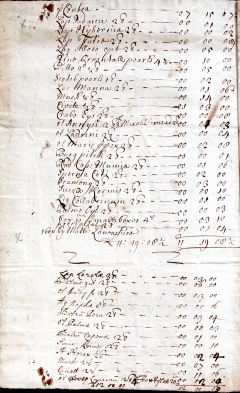 MS Vig. 2
MS Vig. 2
Invoices from Francis Porter dated 1703 March 7, for specimens.
This “1703 March 7” was an old-style date: the year was 1704 by modern reckoning.
Totals:
£11 19s. 8½d. for 62 items;
£2 0s. 9d. for 12 items.
£14 0s. 5½d. for 74 items.

 MS Vig. 4
MS Vig. 4
Invoice from Henry Colchester dated 1703/4 February 18, enclosed within a note dated 1704 April 11.
Left: Columns 1 and 2 of 7.
Right: Column 3 of 7.
Right: Columns 5 and 6 of 7.
Grand total £20 2s. 11½d. for 321 items.
 MS Vig. 6
MS Vig. 6
Receipt signed by John Austin for payment of £10 for cabinet, dated 1704 August 8th.
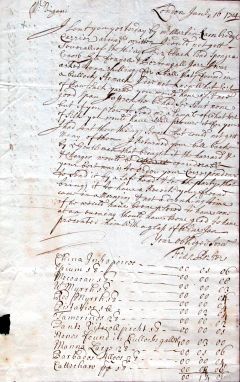
 MS Vig. 8
MS Vig. 8
Invoice from Francis Porter dated 1704 January 16, for specimens.
This “1704 January 16” was an old-style date: the year was 1705 by modern reckoning.
Total £1 2s. 9d. for 30 items.
 MS Vig. 9
MS Vig. 9
Statement on total costs from Vigani, dated 1704/5 February 6, in his handwriting and poor English. Counter-signed by Poley Clopton.
Totals:
£51 07s. 4½d. from invoices, due to him from college;
£22 03s. 0d. previously paid to him for other items.
£73 10s. 4½d. total cost.
Credits
All photographs by Brian Callingham, taken 2003 for the doctoral dissertation of Lisa Wagner.
References and Further Reading
1682: Medulla Chemiæ. Authore Joanne Francisco Vigani Veronensi. (Gdansk) (OCLC 504895945)
1683: Medulla Chemiæ, of ’t Merg der Scheikonst, in welke kortelijk de gansche Chemie afgeleid werd, by Johannes Franciscus Viganus Veronensis. (Amsterdam) (OCLC 69034578)
1683: Medulla Chymiæ, Variis Experimentis aucta, multisq[ue] Figuris illustrata, by Johanne Francisco Vigani Veronensi. (London) (OCLC 38269160)
1684: Acta Eruditorum, 1684 August, pp. 394–5. (OCLC 1460878) [Review of London 1683 edition of Medulla Chymiæ]
1685: Medulla Chymiæ, Variis Experimentis aucta, multisq[ue] Figuris illustrata, by Johanne Francisco Vigani Veronensi. (London, with index) (OCLC 318557093)
1687: Chymia, Jam Variis Experimentis aucta, multisque Figuris illustrata, by Johann. Francisci Vigani. (London, with index) (OCLC 634034936)
1688: another edition (OCLC 181692362)
1693: Medulla Chymiæ, by Johanne Francisco Vigani Veronensi, commentary by David Stam (1633–1711) (Leiden) (OCLC 1222776161)
1693: Κερας Aμαλθειας, seu Thesaurus Remediorum è triplici regno, vegetabili, animali, minerali, ed. Emanuel König, pp. 135–148. (Basel) (OCLC 14296072) [146 recipes reprinted from Medulla Chymiæ]
ca.1699: Cours de Chymie. Joan: Francis: Vigani. Veronensis. University of Cambridge Library MS Dd.12.53. [Transcription in Wagner 2007]
1705: Seignior Vigani’s Course of Chymistry at CAMBRIDGE, Coll. Regin. die Novembr 19 1705. University of Glasgow Library GB 247 MS Ferguson 62.
1707: A Course of Chymistry under Signior Vigani Professor of Chymistry in the University of Cambridge at the Laboratory in Trin. Coll Novbr & December 1707. QC Library MS 62, pp. 1–122. [Found by George Salt in Stockton-on-Tees 1935 December 31; acquired by Ernest Saville Peck, who donated it to this college 1938 October 10. Transcription in Wagner 2007]
1707: another version: MS Eng 685, Houghton Library, Harvard University.
1709: Advertisement for medicines, by Mr. Vigani, Professor of Chymistry (OCLC 1125436475)
1718: Medulla Chymiæ, Variis Experimentis Aucta multisque Figuris illustrata, by Jo. Francisci Vigani Veronensi. (Nuremberg) (OCLC 504207710) [reprint of 1685 ed.]
1730: A course of lectures, upon the Materia Medica, Antient and Modern, by Richard Bradley. (OCLC 14301900) [references Vigani’s collection at Queens’]
1748: Tables of specific gravities, extracted from various authors, with some observations upon the same, by Richard Davies M.D.[Fellow], in Phil. Trans. R. Soc., Vol. 45, No. 488, pp. 416–489. (ISSN 0261-0523, eISSN 2053-9223) [references Vigani’s collection at Queens’ pp. 435–6]
1894: John Francis Vigani: First Professor of Chemistry in the University of Cambridge, by John Ferguson. [read to Cambridge Antiquarian Society 1894 May 16, but never published: typescript carbon copy, on 10¼″ by 8″ paper, watermarked “Excelsior Extra Superfine British Make BCM/SH”. Originated from University of Glasgow (Peck 1934)]
1899: Vigani, John Francis, by John Ferguson, in Dictionary of National Biography, Vol. 58, pp. 305–6.
192x: Substances in cabinet drawers (the “Old Inventory”), anonymous, undated. [Probably by Ernest Saville Peck, around 1922–33, typescript on 10″ by 8″ paper, watermarked “Winterton Bond”]
1933: Some 200 year-old specimens of drugs, by Norman Evers (1887–1972), in The Pharmaceutical Journal and Pharmacist (1933 March 18):219. (ISSN 0301-5432) [Vigani samples]
1934: John Francis Vigani, first Professor of Chemistry in the University of Cambridge (1703–12), and his Materia Medica cabinet in the Library of Queens’ College, by Ernest Saville Peck (1866–1955), Proc. Cambridge Antiquarian Society, Vol. XXXIV (1934):34–49. (ISSN 0309-3603) [Read 1933 February 13]
1936: Catalogue of a loan exhibition of historic scientific apparatus in Cambridge, by Robert William Theodore Gunther, p. 25, item 153. (OCLC 55865226)
1937: Early science in Cambridge, by Robert William Theodore Gunther, p. 333, item 252, & pp. 472–81. (OCLC 2682655) [Vigani himself pp. 221–4, 330–1]
1952: John Francis Vigani: First Professor of Chemistry in the University of Cambridge, by Leslie James Moger Coleby (1904–71), in Annals of Science, Vol. 8, Iss. 1, pp. 46–60. (ISSN 0003-3790 eISSN 1464-505X) [Vigani’s cabinet of Materia Medica survives in Queens’]
1953: Three Early Materia Medica Cabinets in Cambridge, by Ernest Saville Peck (1866–1955), in Medicine Illustrated, Vol. 7, iss. 2, February 1953, pp. 122–9. (ISSN 0266-982X)
1994: The Vigani specimen cabinet by John Austin, a Cambridge joiner, by Adam Bowett, in Regional Furniture, VIII (1994), pp. 58–63. (ISSN 0953-0800)
2002: ‘Boltheads and Crucibles’ : A Brief History of the 1702 Chair of Chemistry at Cambridge, by Christopher David Haley, pp. 3–6. (OCLC 51482640)
2003: Vigani and his cabinet, by Lisa Wagner and Brian Callingham [Fellow], in Queens’ College Record 2003, pp. 14–16. (OCLC 265498993)
2004: Vigani, John Francis (c.1650–1713), by Antonio Clericuzio, in Oxford Dictionary of National Biography.
2005: Vigani and after: chemical enterprise in Cambridge 1680–1780, by Simon Schaffer and Larry Stewart, in The 1702 chair of chemistry at Cambridge : transformation and change, edited by Mary D. Archer & Christopher David Haley, pp. 31–56. (ISBN 978-0-521-82873-4)
2007: Fine Art Materials in Vigani’s Cabinet, 1704, of Queens’ College, Cambridge, by Lisa Wagner, doctoral dissertation, Academy of Fine Arts, Dresden. (OCLC 888712742) [4 vols + DVD-ROM]
2008a: Dr Bentley’s Laboratory, by Robin Carrell, in Trinity College Annual Record 2008, pp. 71–6. [to which Vigani moved his teaching 1707]
2008b: Twenty-first-century Vigani, by Brian Callingham [Fellow], in Queens’ College Record 2008, p. 29. (OCLC 265498993)
2008c: Vigani, John Francis, by A. Rupert Hall, in Complete Dictionary of Scientific Biography, vol. 14, pp. 26–27. (ISBN 978-0-684-80588-7 eISBN 978-0-684-31559-1)
2009: Fine Art Materials in Vigani’s Cabinet, 1704, of Queens’ College, Cambridge, by Lisa Wagner, in Sources and Serendipity : Testimonies of Artists’ Practice, Third Symposium of the Art Technological Source Research Working Group, pp. 79–86. (ISBN 978-1-904982-52-4)
2011: Natural resins and balsams from an eighteenth-century pharmaceutical collection analysed by gas chromatography/mass spectrometry, by Gundel Steigenberger and Christoph Herm, in Anal Bioanal Chem (2011) 401:1771–1784. (ISSN: 1618-2642 (print), 1618-2650 (online))
2013a: The Vigani Cabinet – Analysis of historical resinous materials by gas chromatography - mass spectrometry and infrared spectroscopy, by Gundel Steigenberger, doctoral dissertation, Technical University, Dresden. (OCLC 854842314)
2013b: Some early eighteenth century geological Materia Medica, by Christopher J. Duffin, in A History of Geology and Medicine, edited by Duffin, C. J., Moody, R. T. J. & Gardner-Thorpe, C., Geological Society, London, Special Publications, Vol. 375, 209–233. (ISBN 978-1-86239-643-2)
2014: Natural resins and balsams from an 18th century pharmaceutical collection characterized by Fourier-Transform Infrared Microspectroscopy, by Christoph Herm & Gundel Steigenberger, in 11th Infrared and Raman Users Group Conference Abstracts, pp. 47–52.
2015: A Survey of Artificial Pharmaceutical ‘Stones’ — Part 1, by Christopher J. Duffin and Rachael Pymm, in Pharmaceutical Historian, Vol. 45, No. 1, pp. 2–9, at p. 5. (ISSN 0079-1393)
2016a: Amber as a Component of Palaeontological Pharmacology, by Christopher J. Duffin, in Amber in the history of medicine : Proceedings of the International Conference, eds. I.A. Polyakova, C.J. Duffin, T.J. Suvorova, pp. 95–132. (ISBN 978-5-903920-43-3)
2016b: Investigation of coloured lead glass glitter from an early eighteenth century material collection, Cambridge, by electron microscopy/energy dispersive X-ray analysis, by Gundel Steigenberger & Christoph Herm, in Heritage Science 4:24. (ISSN 2050-7445)
2019: British Eighteenth Century Materia Medica Collections, by Christopher J. Duffin, in Collection in the space of culture : Proceedings of the International Conference, eds. I.A. Polyakova, C.J. Duffin, T.J. Suvorova, pp. 105–125. (ISBN 978-5-903920-52-5)
2020: VIGANI, Giovanni Francesco, by Antonio Clericuzio, in Dizionario Biografico degli Italiani, Volume 99. (ISBN 978-88-12-00032-6)
